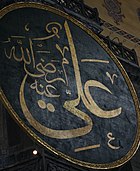
Back اغتيال علي بن أبي طالب Arabic Əlinin qətli Azerbaijani আলীর গুপ্তহত্যা Bengali/Bangla Atentat na Aliju BS Asesinato de Alí Spanish کشتهشدن علی بن ابیطالب Persian Pembunuhan Ali ID قتل علی بن ابی طالب PNB Убийство халифа Али Russian การลอบสังหารอะลี Thai
| Assassination of Ali | |
|---|---|
 The assassination of Ali in a modern painting. | |
| Location | Great Mosque of Kufa, Kufa, present-day Iraq |
| Coordinates | 32°01′43″N 44°24′03″E / 32.02861°N 44.40083°E |
| Date | 28 January 661 |
| Target | Ali ibn Abi Talib |
Attack type | Assassination |
| Weapon | Poison-coated sword |
| Deaths | 1 |
| Victim | Ali ibn Abi Talib |
| Perpetrator | Ibn Muljim |
| Part of a series on |
| Ali |
|---|
 |
| Part of a series on Shia Islam |
|---|
 |
|
|
Ali ibn Abi Talib, the fourth Rashidun caliph (r. 656–661) and the first Shia Imam, was assassinated during the morning prayer on 28 January 661 CE, equivalent to 19 Ramadan 40 AH. He died of his wounds about two days after the Kharijite dissident Ibn Muljim struck him over his head with a poison-coated sword at the Great Mosque of Kufa, located in Kufa, in present-day Iraq. He was about sixty-two years of age at the time of his death.
Ibn Muljim had entered Kufa with the intention of killing Ali, probably in revenge for the Kharijites' defeat in the Battle of Nahrawan in 658. He found two accomplices in Kufa, namely, Shabib ibn Bujra and Wardan ibn al-Mujalid. Unlike Ibn Muljim, the swords of these two missed Ali and they fled, but were later caught and killed. Before his death, Ali requested either a meticulous application of lex talionis to Ibn Muljim or his pardon, and he was later executed by Hasan, the eldest son of Ali. By most accounts, also involved in the assassination was al-Ash'ath ibn Qays, the influential Kufan tribal leader whose loyalty to Ali is often questioned in the early sources. The assassination of Ali paved the way for his rival Mu'awiya to found the Umayyad Caliphate. The shrine of Ali in Najaf, near Kufa, is a major destination for Shia pilgrims.